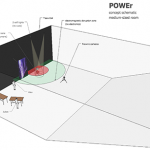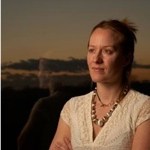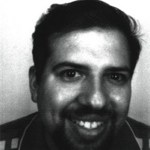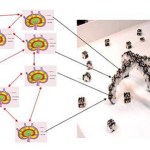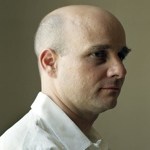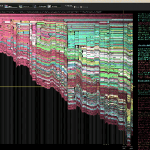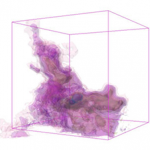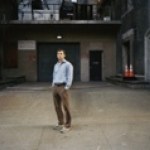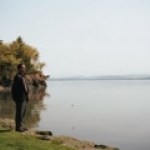
Margaret Turbull's comments about knowing when to build bridges between disciplines (and when not to) is an appropriate final installment of the RevMinds interview series. Over the last several months we've heard our multidisciplinary experts sound off on the following timely questions:
The boundaries of science are continually expanding as scientists become increasingly integral to finding solutions for larger social issues, such as poverty, conflict, financial crises, etc. On what specific issue/problem do you feel we need to bring the scientific lens to bear?
Cross-disciplinary work has…
image: illustration from the POWEr technical rider
In discussing fruitful interdisciplinary collaborations Edward Einhorn identifies a pair of independent theatre collectives that incorporate advanced projection technology and even a Tesla coil into their performances. These groups (3LD and the Collective Unconscious) exemplify how far production and set design has come since the era of Einstein on the Beach—science is not only the stuff of inspiration, or a means to create illusions onstage but experimental technologies can be directly incorporated into a production and foregrounded as…
Below, Margaret Turnbull answers our final question.
Even in my small area of astrobiology, the design of a single mission to find habitable planets orbiting other stars requires substantial input from the studies of astrophysics, space communications, space flight technology, optics, materials science, the interplanetary space environment, Earth's atmospheric system, microbiology, geology, computing, remote sensing, and signal processing. Within each of those areas, input from many sub-disciplines is required. For example, in the "astrophysics" portion of my work I communicate from…
Below, Edward Einhorn answers our final question.
Writing theater about science, in general, has become somewhat more popular, thanks partly (but by no means wholly) on the fact that technology has slowly become a more integral part of theater. This is especially true in small, independent theaters where the technology is not just there to support the work but, in a way, take center stage. Â This fascination ranges from modern technology, such as in the work of the group 3LD, which uses advance projection technology in every show, to technology of a definitely less modern sort—the…
image: a proposed example of an immune-inspired network system, source: SYMBRION & REPLICATOR
In identifying computer science as a nexus of interdisciplinary collaboration, Fernando Esponda cites Artificial Immune Systems (AIS) as research exemplifying this sentiment. Esponda describes AIS as an attempt by computer scientists and immunologists to "learn nature's algorithms for defending the body against pathogens and apply them as another security paradigm to other areas"—an intriguing notion. After a little investigation, one of the most incredible AIS initiatives that I came across…
Below, Skylar Tibbits answers our final question.
Cross-disciplinary approaches have proved useful to gain insight into unknown territories, quickly change scale and application, push past a field's current boundaries and inspire new directions and connections. Varying skills and necessities often become beneficial characteristics for collaboration between domains. Each person can bring insight, real-world application, understanding of production, and specific expertise to complete even the most complicated tasks. Currently, mechanical and electrical engineers, computer scientists,…
Below, Fernando Esponda answers our final question.
Computer science is a discipline that is intrinsically interdisciplinary. Primarily because the computer itself—the externalization of our logic apparatus—is such an enticing and versatile tool. Therefore, it is not hard to find examples of cross-disciplinary approaches. Just think of Artificial Intelligence and all the areas it draws upon. A less well-known example is the subject of Artificial Immune Systems (AIS) in which I've done some work. Here, computer scientists and immunologists are collaborating to, among other things, learn…
image: history flow edit log of the Wikipedia article on evolution
Nick Matzke is ambitious when he exercises his imagination. In answering our final question, Matzke sketches out a methodology for tracking how public policies or scientific hypotheses were "copied, repeated, modified and propagated" to see how society (and the passage of time) nurtures the spread of ideas. Matzke rightly points to memetics as an important precedent and it is clear that this reference, when coupled with his earlier call for docuinformatics (data driven historical scholarship) clearly illustrates a desire to…
Below, John Wilbanks answers our final question.
Cross-disciplinarity seems to work best when there's a problem that has a few facets that are apparently unconnected, but the disconnect comes from the artificial way we divide up the knowledge. Because in reality the problem is simply the problem, but scientists get trained into reductively narrow disciplines to become experts in those disciplines, get grants, and get tenure. Overcoming the narrow reductive natures that get trained is one of the challenges here—the scientists on cross-discipline teams spend a ton of time just learning the…
I erroneously titled the post that contained Michelle Borkin's final answer "Collaboration and Hemodynamics"
and this definitely reflected an oversight on my part. In addition to discussing hemodynamics Michelle also touched on the Astronomical Medicine project, a venture that definitely deserves some attention as it is a great example of interdisciplinary collaboration. What exactly is the mandate of the project and around which circumstances or scientific problems might astronomers and medical imaging specialists collaborate? Data Visualization. At this moment in time that answer isn't…
Below, Nick Matzke answers our final question.
Continuing the previous theme - I recently got interested in the origin of a particular apocryphal quote attributed to a famous scientist. The quote exists in hundreds of books and tens of thousands of webpages, but the scientist in question never said it, and no one seems to know where the quote came from (sorry to be coy, I am writing this up for publication and don't want to spoil the surprise). I believe I have finally traced it to its source, and the fascinating thing is that the quote has evolved through time, gradually becoming shorter…
Well, since Josh Ruxin's thoughts on private sector strategies in medical management were so popular it is clear that the RevMinds community is hungry for additional perspective on healthcare as a nexus of multidisciplinary action. As I mentioned in my follow-up post, data and health care (specifically data portability within medical records) is a topic that has bubbled up to the foreground of the open data movement. Medical records are an interesting topic as they represent the administrative process that Ruxin is so bent on overhauling and also provoke questions of ownership and patient-…
Below, Michelle Borkin answers our final question.
I have seen many cross-disciplinary approaches work successfully. These approaches are sometimes initially in the application of a tool or technique from one field to another, but ultimately lead to two-way conversations and better or new technologies to advance both fields. For my experience working at Harvard on the Astronomical Medicine project, the mutual need for sophisticated multidimensional data visualization techniques of image data cubes is the motivation for astronomers and radiologists working together. Both fields are able to…
Josh Ruxin has provided a thoughtful, measured description of how private sector management strategies could improve health care in developing countries. He drives this point home by highlighting the prevalence of dead-simple "institutional failures" such as convoluted daily schedules and bad accounting. How can we address these "cascading problems" and rethink healthcare (acknowledging that this is a universal problem—not just limited to developing countries)?
A little research yielded the above big think video interview where Ruxin outlines his experience directing Rwanda Works. Ruxin…
Below, Josh Ruxin answers our final question.
Hands down, the application of private sector management solutions to health care, particularly in developing countries, is vital, and, almost utterly unfinanced. The focus of public health systems continues to be on training and retraining personnel, and identifying gaps in specific administrative systems. There's a raft of research on drug procurement systems, billing systems, and electronic patient medical records. The industry has come to resemble the three blind men each touching a different part of the elephant and trying to…
Below, Moshe Pritsker answers our final question.
Genomics is a good example of a cross-disciplinary approach that produced a landmark shift in biomedical research, drug discovery, and other life science areas. Enabling single experiments that produce amounts of data that would require thousands or millions of experiments just a few years ago led to a drastic increase in the information on biological and medical molecular-level processes. Genomics has changed the technical foundation of biomedical sciences and strongly reshaped the conceptual thinking in this field. The changes introduced…
Below, Gladys Kalema-Zikusoka answers our final question.
The cross disciplinary approaches I have seen working in my field are integrating population, health and environmental issues, where if done on their own as has been the traditional approach, less results are achieved than when combined. Integration appears to strengthen the social and environmental impact. We are already seeing the benefits of this in a non-profit and NGO that we founded called Conservation Through Public Health. For two years we have been implementing a community based family planning program with a community based…
Saleem Ali's brief overview of the evolution of ecological economic thinking is fascinating. I wasn't familiar with Nicholas Georgescu-Roegen until reading Ali's description of The Entropy Law and the Economic Process. A quick search on Google turned up a 1986 paper by Georgescu-Roegen entitled "The Entropy Law and the Economic Process in Retrospect" that provides a good introduction and contextualization of the work. Within the paper, Georgescu-Roegen identifies the lineage of his research:
To be sure, the formal analogy between the basic equations of thermodynamics and some of those used…
Below, Saleem Ali answers our final question.
The most productive interface between disciplines in the environmental sciences has occurred in understanding the value of ecosystem services. There has been a remarkable growth in the last five years in mainstream research within economics, physics, and ecology that shows how natural systems provide benefits that can be tangibly "valued." While some environmental ethicists, such as Mark Sagoff, have resisted the call to put numeric values on nature, there is little doubt that without having such clear numerical information, natural value will…
Below, Lambros Malafouris answers our final question.
Judging from the experience I have gathered so far working in various cross-disciplinary projects, I have to say that there is no such thing as an "appropriate" or "inappropriate" approach; there is only what we may call "soft" and "hard" cross-disciplinary research. The former type is quite common; I would say even fashionable in many fields and countries, yet of little value. It simply means, in most cases, that you combine or add perspectives in order to study a phenomenon or answer a certain question. At best this will result in a…
